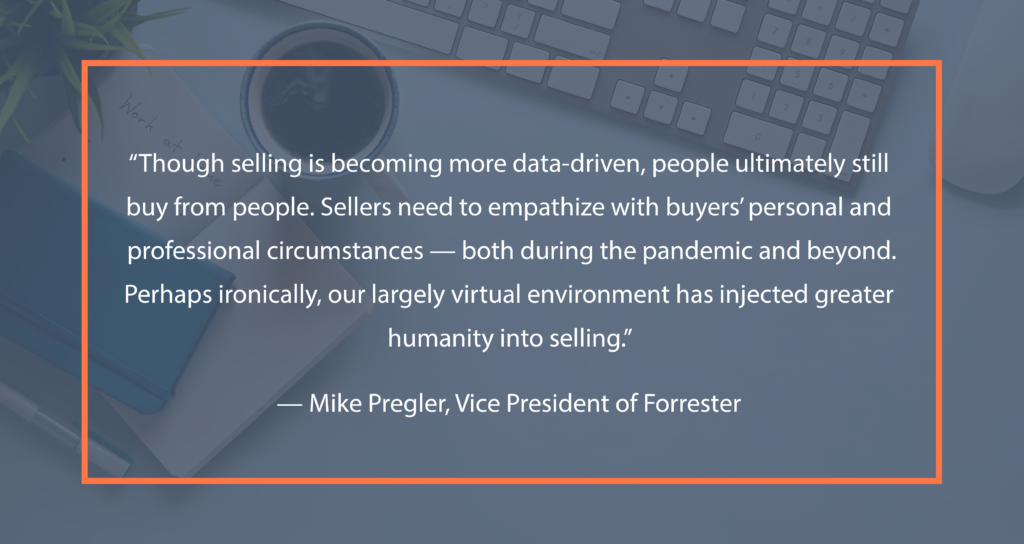
Are you ready to empower your sales teams during COVID in 2021?
This blog is the second in our two-part series on managing remote sales teams during COVID. Click here to read part one, which focuses on ways top sales managers successfully shifted their operations to ensure the success of their reps in the new standard of remote sales.
In 2020, businesses across the United States abruptly moved their entire staff to remote work as states issued lockdown orders due to the spread of COVID-19. The pandemic pushed organizations with office cultures and everyday face-to-face sales interactions to entirely digital transactions in a short amount of time.
Of course, in an era of technology, sales organizations had already employed some digital strategies for efficient engagement with potential buyers. But COVID accelerated the extent of the shift. In the future, at least 80 percent of the B2B sales cycle is expected to happen in digital settings, according to Forrester.
So what have organizations done in the time of COVID to successfully fast-track their sales teams for remote work? In this second part, we look at the other side — the customer side — and the sales strategies used to engage decision-makers and close deals while working remotely.
It’s Still About Relationships
Any set of strategies needs to recognize you are still in the relationship business and technology is not an end itself, but the means to create new, meaningful opportunities to truly connect with buyers.
“Though selling is becoming more data-driven, people ultimately still buy from people. Sellers need to empathize with buyers’ personal and professional circumstances — both during the pandemic and beyond. Perhaps ironically, our largely virtual environment has injected greater humanity into selling.”
— Mike Pregler, vice president, research director, Sales Executive Services, Forrester

Forget the Phone Call. Engage with Video
Video blogs, video tutorials and presentations, product demos, testimonials and conversations — for B2B sellers, video has become a powerful tool and differentiator for engaging potential customers. If sales teams and their managers weren’t experts before, remote sales has been the push into a new realm.
For instance, at Canvas GFX, Becky Darsch, vice president of global sales, has adopted a newer video solution to prospecting. With the tool, her sales team creates one-minute video messages that are packaged in an email introduction for a brief, personal interaction. COVID has also changed the process of doing customer business via video, especially as many agree that business travel will never return to its previous pace.
“That notion hit soon into the shift to remote work,” Darsch said — which prompted the company to institute video use for customer interactions 100 percent of the time. “Even if the customers don’t click their videos,” she said.
With that change came investments into standalone lighting (“We look better.”); initial employee training on professional video calls; and continual updates passed onto employees “to keep us innovating as we adapt to this new world,” Darsch said.
The benefit of videoconferencing sales calls has been twofold: personal face-to-face engagement to build relationships and work through issues faster.
Adopt AI and Automation
Artificial intelligence (AI) and automation are two of the fastest-growing technologies as they become more accessible to sales organizations of all sizes — and the considerable potential and benefits are better understood.
Even during the business upset of 2020, a HubSpot survey of over 500 sales leaders in eight countries showed 61 percent of those who exceeded revenue targets used CRM tools to automate aspects of their sales process such as scheduling meetings, delivering content, and generating contracts. And 44 percent of those who met or exceeded revenue projections used competitive intelligence and market data.
Randy Bernard, vice president of sales at Digital.ai Software, Inc. (formerly XebiaLabs), uses an account-based marketing (ABM) automation platform to align sales and marketing to identify key prospects and then create targeted and coordinated outreach attempts.
The ABM helps understand when people are engaging with your content, Bernard said, and allows impact to be quantified, and prospect engagement tracked, to focus efforts and drive leads.
Create Customized Content
Content is king for conducting outreach and sparking curiosity. Make it relevant, and you’ve made a valuable connection.
“Part of our opportunity is making people aware that we exist,” Darsch said. Sometimes, the only intent in creating content is to produce something eye-catching that plants a seed and introduces them to the product, no call-to-action included.
“We’re not asking them for something, but instead, we give them something and show value,” she said. What’s important is that the content is personalized for the buyer experience.
Selling is harder in the current environment, Bernard said, and you must find ways to better establish value. He uses a content experience platform to create personalized content destinations. Content experience platforms elevate engagement by consolidating information and creating a custom design experience. Combining any number of blogs, videos, e-books, and even social media, the platform creates a unique hub of information designed for a specific prospect.
“It’s like a content repository, where you can streamline your content, laid out for the customer, with tracking to understand what content a prospect is consuming and when things are top of mind,” he said.
Employ Multithreading, Account Planning
In a remote work setting, your sales teams must earlier introduce account planning, researching, and multithreading, Bernard said, tactics that might normally be employed later in the process.
Consider these key statistics, from a LinkedIn study:
• There are approximately 7 decision-makers involved in the average B2B purchase.
• Deal sizes are 43 percent lower when not multithreaded.
• Average bookings are 88 percent higher, and the deal cycles 14 percent shorter, when multithreaded.
Account planning and multithreading are going to be crucial now because you can’t call and get everyone in the same office, Bernard said.
“None of this is new, it’s just become a heightened priority,” he said. Which, in turn, is making his company far more process-oriented, establishing goals, using metrics, writing profiles, and setting multiple hooks.
“In this day and age, that fish on the hook, it can get off much easier,” he said. As an offset, “you want to do more multithreading and account planning,” he said.
Shorten the Time to JEP Within Remote Sales
Before COVID, during the relationship-building process, sales calls might end with an agreement to talk the following week, Bernard said. In a remote work situation, you have to collapse the time frame for creating a joint engagement plan (JEP), otherwise known as a mutual action plan (MAP) or close plan. Now, he has his sales team set future commitments on the very first call.
“We have a firm commitment with a time and an agenda,” he said, “even if it’s only for a five-minute check-in.”
Enforce a Methodology with Your Sales Teams
The highest priority in a remote sales setting is to endorse a sales methodology, to streamline actions and encourage teamwork, Bernard said. “Whether it’s SPIN or MEDDIC,” he said, “you must have one that everyone is using to promote synergy and consistency across a team.”
Bernard uses MEDDIC (metrics, economic buyer, decision criteria, decision process, identify pain, champion). And the four-stage SPIN (situation, problem, implication, need payoff) was introduced more than 30 years ago, but with its focus on building relationships has received renewed attention for today’s sales situations.

“By everyone using the same process, they ask the same questions, and it encourages teamwork in a remote setting in ways that would naturally happen with everyone in an office,” Bernard said.
Find New Marketing and New Ways to Get in Touch
This may seem like a given. But in an era where other companies are going through the same digital acceleration yours is, there may be ways to pivot to spaces that you wouldn’t normally, but that are thriving and could, in that environment, be a good fit.
Once new targets are found, use technology to get in touch. ZoomInfo has been an invaluable tool, Darsch said, in seeking contact information for those who have dispersed to home offices.
“ZoomInfo has really stepped up their game to get cell phone numbers into their database by title, location, by specific division, and email. That technology has been super meaningful,” she said.
Remember Flexibility, Empathy, and Authenticity
Last year, when deals that were in the final stages continued to trickle in and others in the early stages came to a halt, “we made a conscious decision not to sell,” Bernard said. Digital.ai instead decided to slow down completely. There were no layoffs, and the company continued to employ and bring in new hires in anticipation of ramping back up.
“We went from selling value and technology to sending Christmas cards,” he said. “We took an empathetic approach. It helped us maintain relationships.”
COVID has changed the interaction. Remote sales people may be on a customer call, and the dog is barking, UPS is at the door, and there may be kids busting in.
“That’s the reality of where everyone is,” Darsch said. “We’ve used that to show our authenticity. I think it will forever change the way we do business. This has humanized everyone.”
The pandemic pushed sales organizations to embrace technology, and a digital work environment, more than ever. In the process, both buyers and sales teams have discovered increased convenience and flexibility, as well as in some cases broader reach. However, the need for human experience will never disappear from the sales experience.
Let You Sales Teams Discover the Dana Difference
At DANA Associates, we know that face-to-face conversations are the most significant tool in a recruiter’s toolbox, and the need for sellers to become digitally adept will not eliminate the need for them to be humanly adept as well. If anything, sellers will need to continue to master the art of relationship building even more so in the future. If you are ready to discover the DANA difference and build your sales teams to power growth, contact us today to schedule an introductory call.

